Comprehensive Report: Reward Management Theories and Implementation
VerifiedAdded on 2020/06/05
|17
|5742
|72
Report
AI Summary
This report delves into the realm of reward management, examining its critical role in motivating employees and enhancing their performance within organizations. It explores various theoretical frameworks, including early theories such as Maslow's Hierarchy of Needs, ERG theory, and Herzberg's Two-Factor Theory, providing insights into the fundamental drivers of employee behavior. The report then transitions to process theories, such as Equity Theory and Expectancy Theory, illustrating how employees perceive fairness and the relationship between effort, performance, and rewards. Furthermore, it highlights the practical implications of these theories, offering a comprehensive understanding of reward management strategies and their impact on both individual and team levels, ultimately contributing to improved organizational outcomes. The report concludes with a reflection on the application of these theories in real-world scenarios.
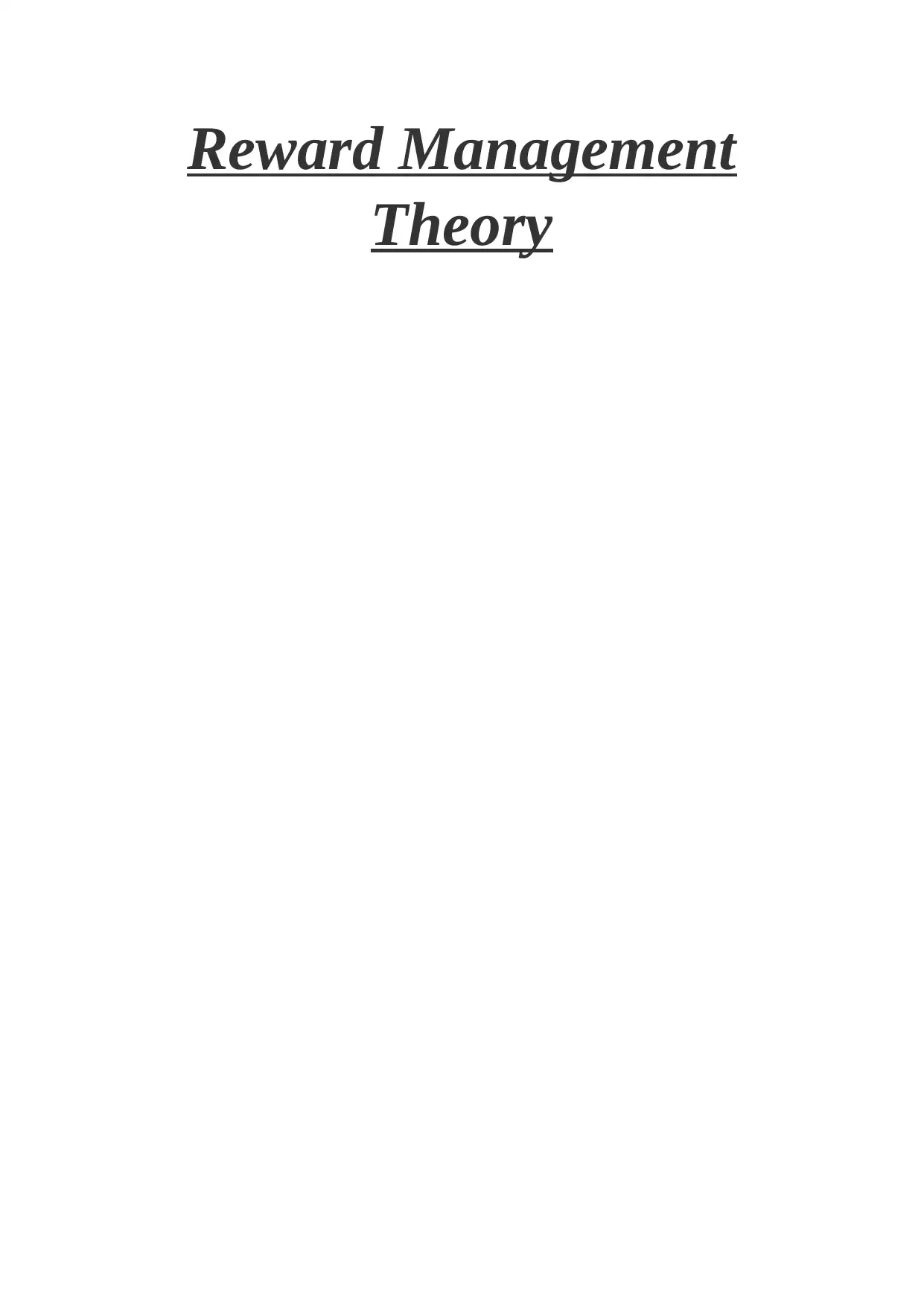
Reward Management
Theory
Theory
Paraphrase This Document
Need a fresh take? Get an instant paraphrase of this document with our AI Paraphraser
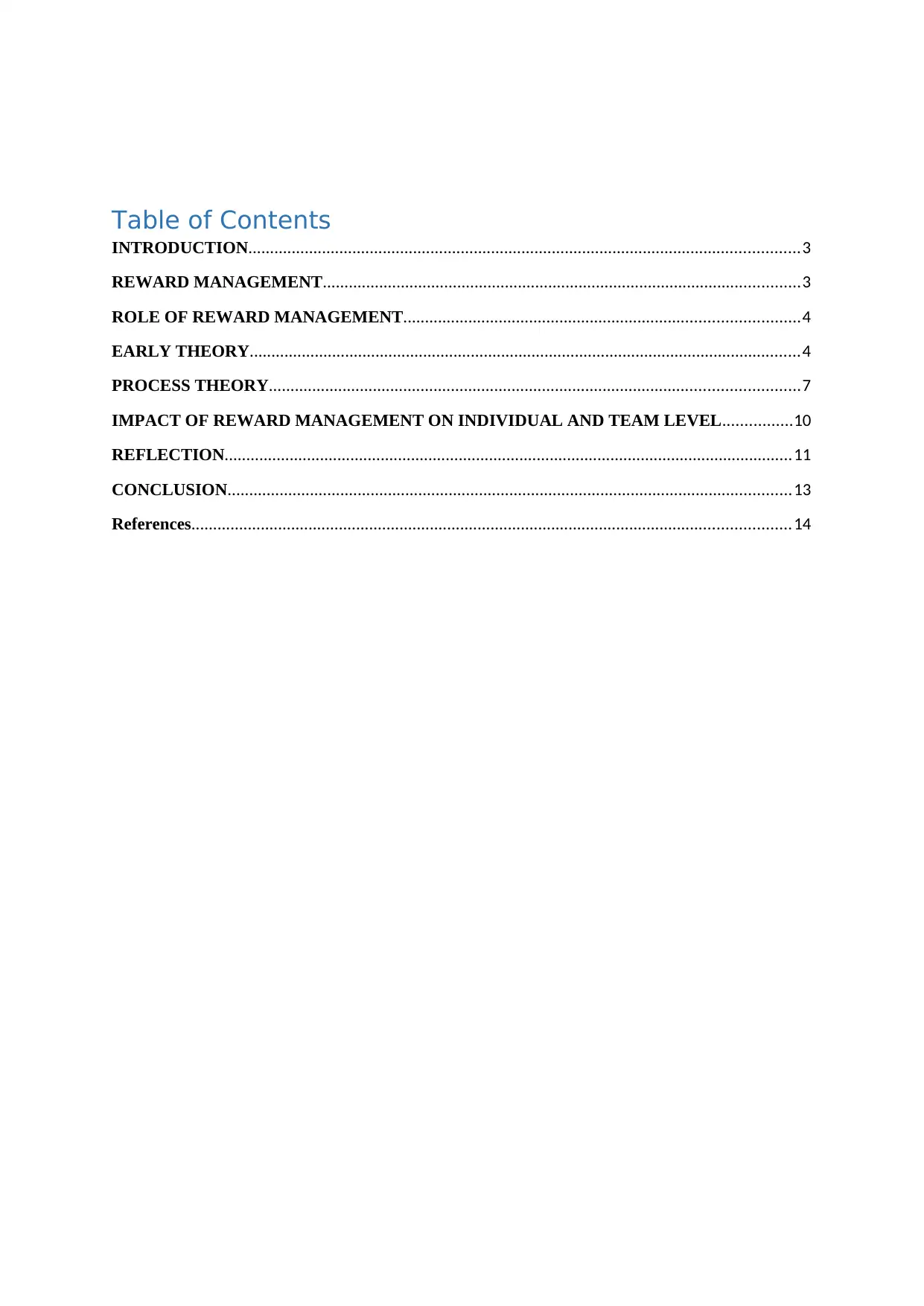
Table of Contents
INTRODUCTION...............................................................................................................................3
REWARD MANAGEMENT..............................................................................................................3
ROLE OF REWARD MANAGEMENT...........................................................................................4
EARLY THEORY...............................................................................................................................4
PROCESS THEORY..........................................................................................................................7
IMPACT OF REWARD MANAGEMENT ON INDIVIDUAL AND TEAM LEVEL................10
REFLECTION...................................................................................................................................11
CONCLUSION..................................................................................................................................13
References..........................................................................................................................................14
INTRODUCTION...............................................................................................................................3
REWARD MANAGEMENT..............................................................................................................3
ROLE OF REWARD MANAGEMENT...........................................................................................4
EARLY THEORY...............................................................................................................................4
PROCESS THEORY..........................................................................................................................7
IMPACT OF REWARD MANAGEMENT ON INDIVIDUAL AND TEAM LEVEL................10
REFLECTION...................................................................................................................................11
CONCLUSION..................................................................................................................................13
References..........................................................................................................................................14
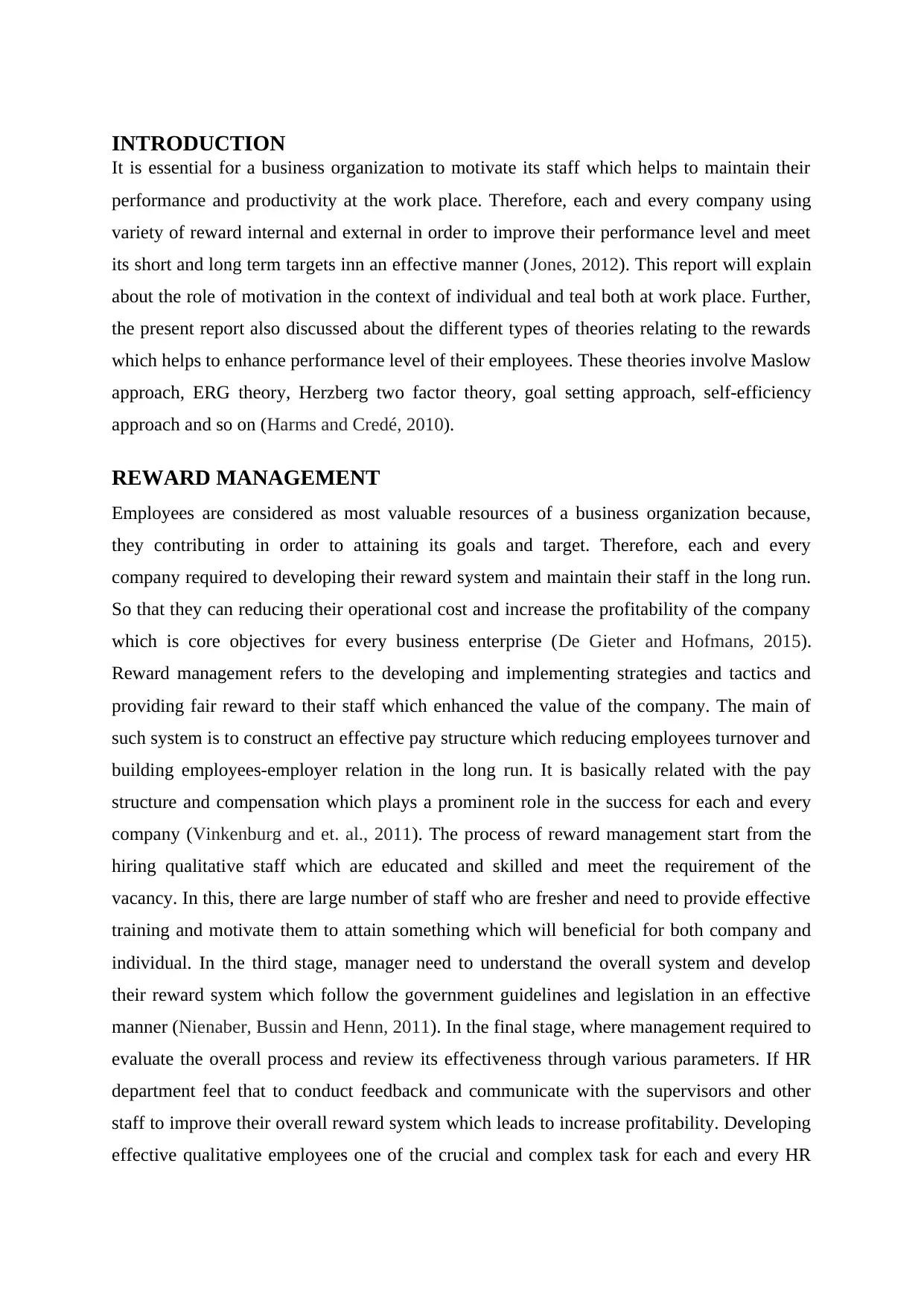
INTRODUCTION
It is essential for a business organization to motivate its staff which helps to maintain their
performance and productivity at the work place. Therefore, each and every company using
variety of reward internal and external in order to improve their performance level and meet
its short and long term targets inn an effective manner (Jones, 2012). This report will explain
about the role of motivation in the context of individual and teal both at work place. Further,
the present report also discussed about the different types of theories relating to the rewards
which helps to enhance performance level of their employees. These theories involve Maslow
approach, ERG theory, Herzberg two factor theory, goal setting approach, self-efficiency
approach and so on (Harms and Credé, 2010).
REWARD MANAGEMENT
Employees are considered as most valuable resources of a business organization because,
they contributing in order to attaining its goals and target. Therefore, each and every
company required to developing their reward system and maintain their staff in the long run.
So that they can reducing their operational cost and increase the profitability of the company
which is core objectives for every business enterprise (De Gieter and Hofmans, 2015).
Reward management refers to the developing and implementing strategies and tactics and
providing fair reward to their staff which enhanced the value of the company. The main of
such system is to construct an effective pay structure which reducing employees turnover and
building employees-employer relation in the long run. It is basically related with the pay
structure and compensation which plays a prominent role in the success for each and every
company (Vinkenburg and et. al., 2011). The process of reward management start from the
hiring qualitative staff which are educated and skilled and meet the requirement of the
vacancy. In this, there are large number of staff who are fresher and need to provide effective
training and motivate them to attain something which will beneficial for both company and
individual. In the third stage, manager need to understand the overall system and develop
their reward system which follow the government guidelines and legislation in an effective
manner (Nienaber, Bussin and Henn, 2011). In the final stage, where management required to
evaluate the overall process and review its effectiveness through various parameters. If HR
department feel that to conduct feedback and communicate with the supervisors and other
staff to improve their overall reward system which leads to increase profitability. Developing
effective qualitative employees one of the crucial and complex task for each and every HR
It is essential for a business organization to motivate its staff which helps to maintain their
performance and productivity at the work place. Therefore, each and every company using
variety of reward internal and external in order to improve their performance level and meet
its short and long term targets inn an effective manner (Jones, 2012). This report will explain
about the role of motivation in the context of individual and teal both at work place. Further,
the present report also discussed about the different types of theories relating to the rewards
which helps to enhance performance level of their employees. These theories involve Maslow
approach, ERG theory, Herzberg two factor theory, goal setting approach, self-efficiency
approach and so on (Harms and Credé, 2010).
REWARD MANAGEMENT
Employees are considered as most valuable resources of a business organization because,
they contributing in order to attaining its goals and target. Therefore, each and every
company required to developing their reward system and maintain their staff in the long run.
So that they can reducing their operational cost and increase the profitability of the company
which is core objectives for every business enterprise (De Gieter and Hofmans, 2015).
Reward management refers to the developing and implementing strategies and tactics and
providing fair reward to their staff which enhanced the value of the company. The main of
such system is to construct an effective pay structure which reducing employees turnover and
building employees-employer relation in the long run. It is basically related with the pay
structure and compensation which plays a prominent role in the success for each and every
company (Vinkenburg and et. al., 2011). The process of reward management start from the
hiring qualitative staff which are educated and skilled and meet the requirement of the
vacancy. In this, there are large number of staff who are fresher and need to provide effective
training and motivate them to attain something which will beneficial for both company and
individual. In the third stage, manager need to understand the overall system and develop
their reward system which follow the government guidelines and legislation in an effective
manner (Nienaber, Bussin and Henn, 2011). In the final stage, where management required to
evaluate the overall process and review its effectiveness through various parameters. If HR
department feel that to conduct feedback and communicate with the supervisors and other
staff to improve their overall reward system which leads to increase profitability. Developing
effective qualitative employees one of the crucial and complex task for each and every HR
⊘ This is a preview!⊘
Do you want full access?
Subscribe today to unlock all pages.

Trusted by 1+ million students worldwide
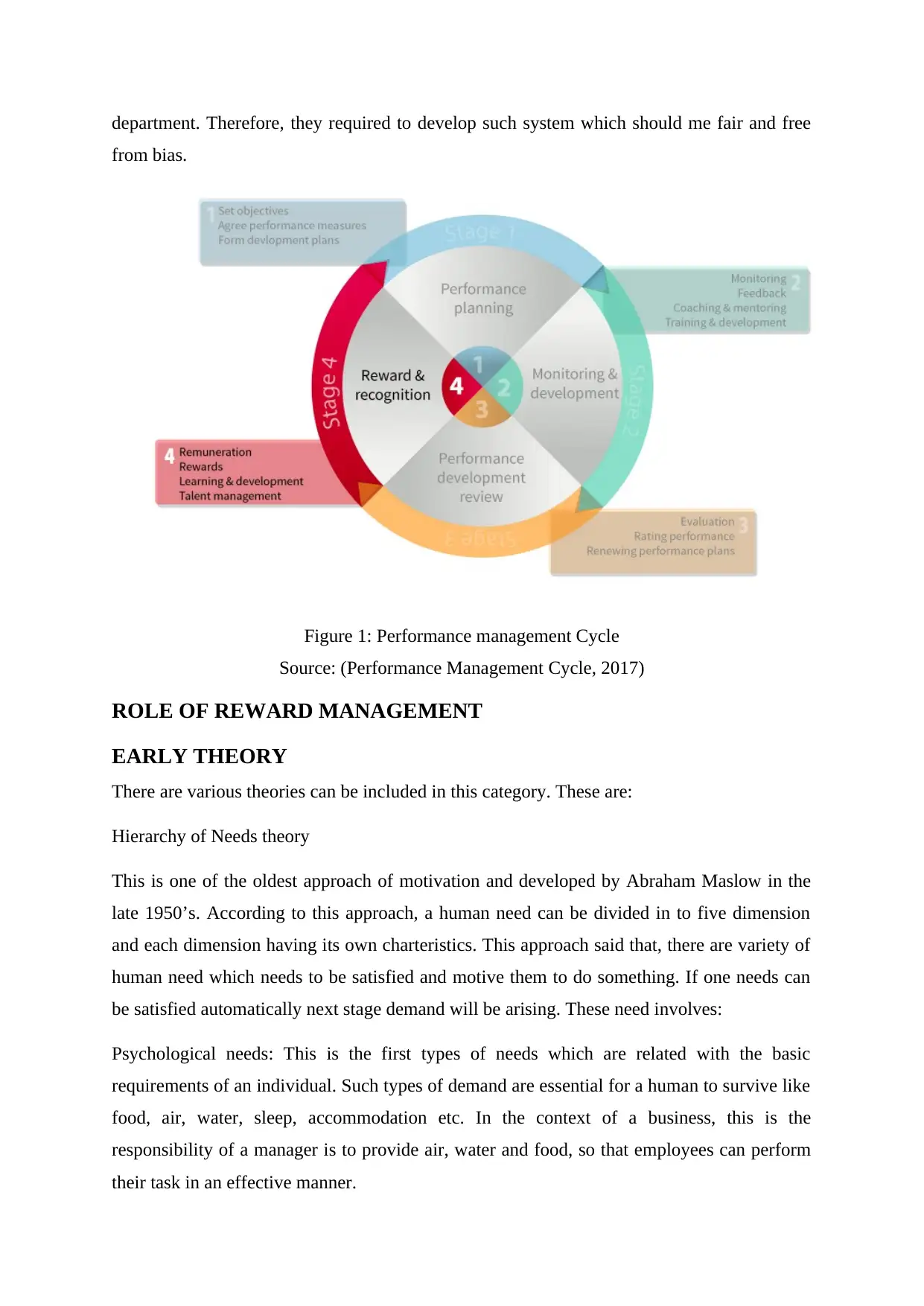
department. Therefore, they required to develop such system which should me fair and free
from bias.
Figure 1: Performance management Cycle
Source: (Performance Management Cycle, 2017)
ROLE OF REWARD MANAGEMENT
EARLY THEORY
There are various theories can be included in this category. These are:
Hierarchy of Needs theory
This is one of the oldest approach of motivation and developed by Abraham Maslow in the
late 1950’s. According to this approach, a human need can be divided in to five dimension
and each dimension having its own charteristics. This approach said that, there are variety of
human need which needs to be satisfied and motive them to do something. If one needs can
be satisfied automatically next stage demand will be arising. These need involves:
Psychological needs: This is the first types of needs which are related with the basic
requirements of an individual. Such types of demand are essential for a human to survive like
food, air, water, sleep, accommodation etc. In the context of a business, this is the
responsibility of a manager is to provide air, water and food, so that employees can perform
their task in an effective manner.
from bias.
Figure 1: Performance management Cycle
Source: (Performance Management Cycle, 2017)
ROLE OF REWARD MANAGEMENT
EARLY THEORY
There are various theories can be included in this category. These are:
Hierarchy of Needs theory
This is one of the oldest approach of motivation and developed by Abraham Maslow in the
late 1950’s. According to this approach, a human need can be divided in to five dimension
and each dimension having its own charteristics. This approach said that, there are variety of
human need which needs to be satisfied and motive them to do something. If one needs can
be satisfied automatically next stage demand will be arising. These need involves:
Psychological needs: This is the first types of needs which are related with the basic
requirements of an individual. Such types of demand are essential for a human to survive like
food, air, water, sleep, accommodation etc. In the context of a business, this is the
responsibility of a manager is to provide air, water and food, so that employees can perform
their task in an effective manner.
Paraphrase This Document
Need a fresh take? Get an instant paraphrase of this document with our AI Paraphraser
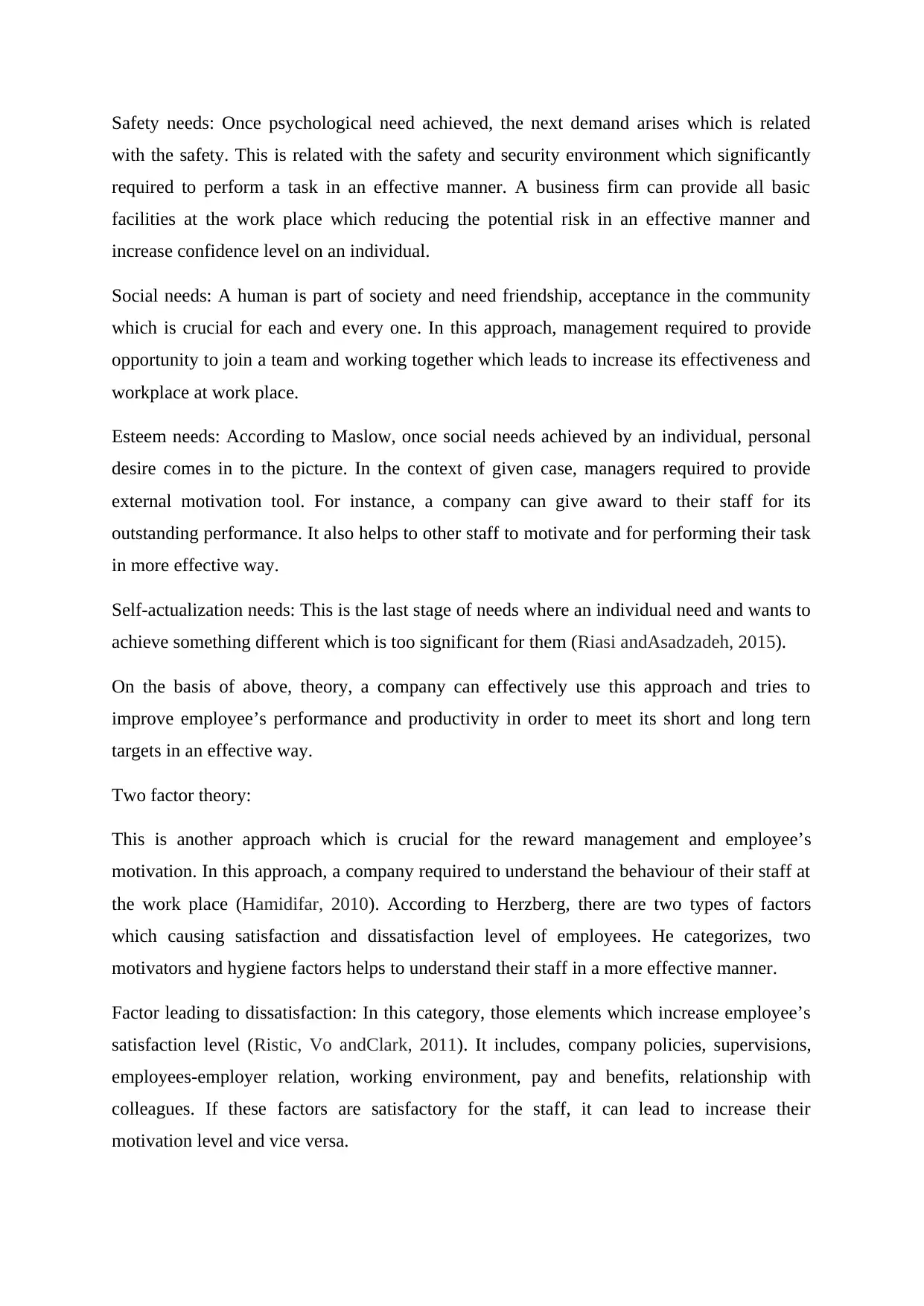
Safety needs: Once psychological need achieved, the next demand arises which is related
with the safety. This is related with the safety and security environment which significantly
required to perform a task in an effective manner. A business firm can provide all basic
facilities at the work place which reducing the potential risk in an effective manner and
increase confidence level on an individual.
Social needs: A human is part of society and need friendship, acceptance in the community
which is crucial for each and every one. In this approach, management required to provide
opportunity to join a team and working together which leads to increase its effectiveness and
workplace at work place.
Esteem needs: According to Maslow, once social needs achieved by an individual, personal
desire comes in to the picture. In the context of given case, managers required to provide
external motivation tool. For instance, a company can give award to their staff for its
outstanding performance. It also helps to other staff to motivate and for performing their task
in more effective way.
Self-actualization needs: This is the last stage of needs where an individual need and wants to
achieve something different which is too significant for them (Riasi andAsadzadeh, 2015).
On the basis of above, theory, a company can effectively use this approach and tries to
improve employee’s performance and productivity in order to meet its short and long tern
targets in an effective way.
Two factor theory:
This is another approach which is crucial for the reward management and employee’s
motivation. In this approach, a company required to understand the behaviour of their staff at
the work place (Hamidifar, 2010). According to Herzberg, there are two types of factors
which causing satisfaction and dissatisfaction level of employees. He categorizes, two
motivators and hygiene factors helps to understand their staff in a more effective manner.
Factor leading to dissatisfaction: In this category, those elements which increase employee’s
satisfaction level (Ristic, Vo andClark, 2011). It includes, company policies, supervisions,
employees-employer relation, working environment, pay and benefits, relationship with
colleagues. If these factors are satisfactory for the staff, it can lead to increase their
motivation level and vice versa.
with the safety. This is related with the safety and security environment which significantly
required to perform a task in an effective manner. A business firm can provide all basic
facilities at the work place which reducing the potential risk in an effective manner and
increase confidence level on an individual.
Social needs: A human is part of society and need friendship, acceptance in the community
which is crucial for each and every one. In this approach, management required to provide
opportunity to join a team and working together which leads to increase its effectiveness and
workplace at work place.
Esteem needs: According to Maslow, once social needs achieved by an individual, personal
desire comes in to the picture. In the context of given case, managers required to provide
external motivation tool. For instance, a company can give award to their staff for its
outstanding performance. It also helps to other staff to motivate and for performing their task
in more effective way.
Self-actualization needs: This is the last stage of needs where an individual need and wants to
achieve something different which is too significant for them (Riasi andAsadzadeh, 2015).
On the basis of above, theory, a company can effectively use this approach and tries to
improve employee’s performance and productivity in order to meet its short and long tern
targets in an effective way.
Two factor theory:
This is another approach which is crucial for the reward management and employee’s
motivation. In this approach, a company required to understand the behaviour of their staff at
the work place (Hamidifar, 2010). According to Herzberg, there are two types of factors
which causing satisfaction and dissatisfaction level of employees. He categorizes, two
motivators and hygiene factors helps to understand their staff in a more effective manner.
Factor leading to dissatisfaction: In this category, those elements which increase employee’s
satisfaction level (Ristic, Vo andClark, 2011). It includes, company policies, supervisions,
employees-employer relation, working environment, pay and benefits, relationship with
colleagues. If these factors are satisfactory for the staff, it can lead to increase their
motivation level and vice versa.
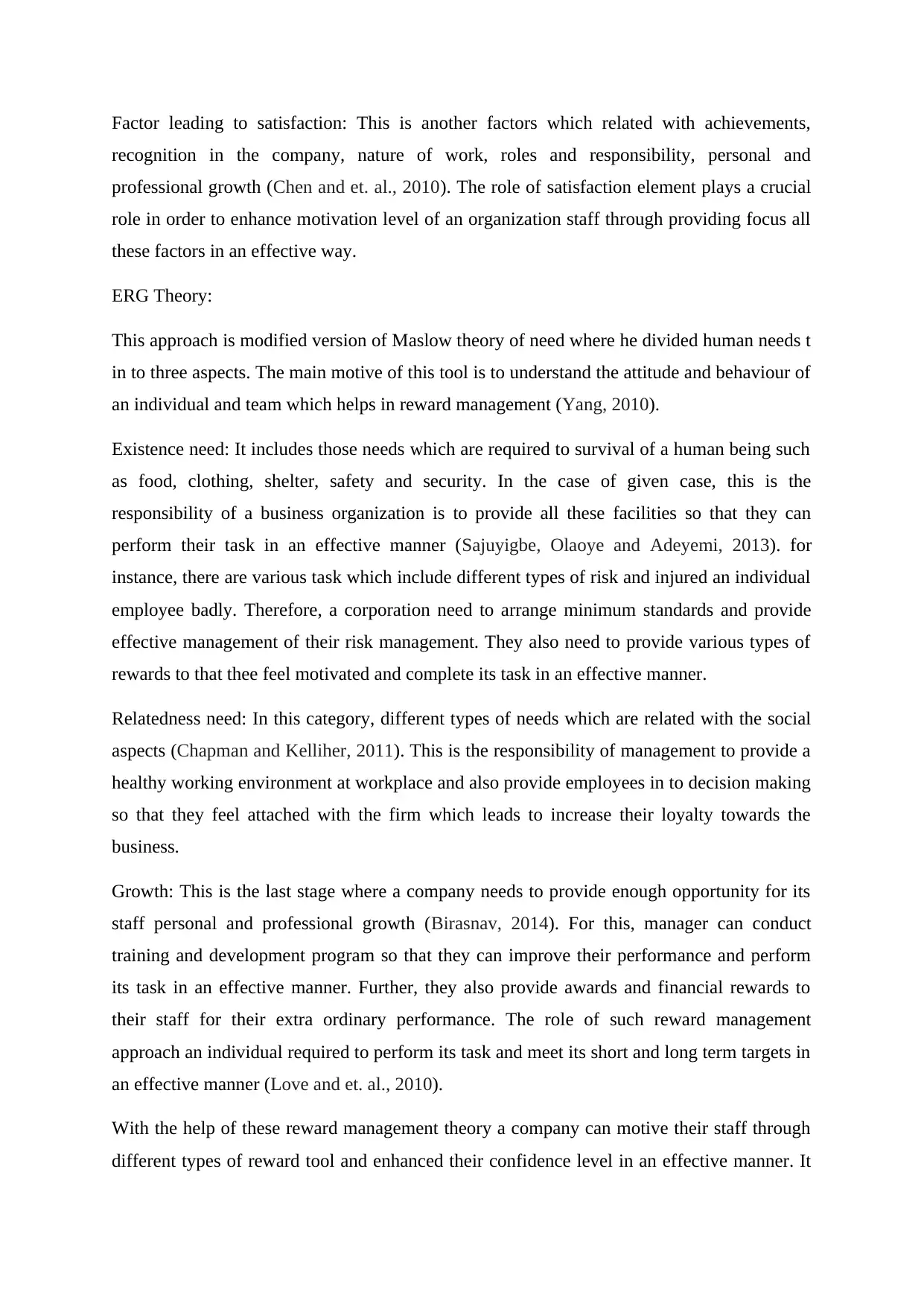
Factor leading to satisfaction: This is another factors which related with achievements,
recognition in the company, nature of work, roles and responsibility, personal and
professional growth (Chen and et. al., 2010). The role of satisfaction element plays a crucial
role in order to enhance motivation level of an organization staff through providing focus all
these factors in an effective way.
ERG Theory:
This approach is modified version of Maslow theory of need where he divided human needs t
in to three aspects. The main motive of this tool is to understand the attitude and behaviour of
an individual and team which helps in reward management (Yang, 2010).
Existence need: It includes those needs which are required to survival of a human being such
as food, clothing, shelter, safety and security. In the case of given case, this is the
responsibility of a business organization is to provide all these facilities so that they can
perform their task in an effective manner (Sajuyigbe, Olaoye and Adeyemi, 2013). for
instance, there are various task which include different types of risk and injured an individual
employee badly. Therefore, a corporation need to arrange minimum standards and provide
effective management of their risk management. They also need to provide various types of
rewards to that thee feel motivated and complete its task in an effective manner.
Relatedness need: In this category, different types of needs which are related with the social
aspects (Chapman and Kelliher, 2011). This is the responsibility of management to provide a
healthy working environment at workplace and also provide employees in to decision making
so that they feel attached with the firm which leads to increase their loyalty towards the
business.
Growth: This is the last stage where a company needs to provide enough opportunity for its
staff personal and professional growth (Birasnav, 2014). For this, manager can conduct
training and development program so that they can improve their performance and perform
its task in an effective manner. Further, they also provide awards and financial rewards to
their staff for their extra ordinary performance. The role of such reward management
approach an individual required to perform its task and meet its short and long term targets in
an effective manner (Love and et. al., 2010).
With the help of these reward management theory a company can motive their staff through
different types of reward tool and enhanced their confidence level in an effective manner. It
recognition in the company, nature of work, roles and responsibility, personal and
professional growth (Chen and et. al., 2010). The role of satisfaction element plays a crucial
role in order to enhance motivation level of an organization staff through providing focus all
these factors in an effective way.
ERG Theory:
This approach is modified version of Maslow theory of need where he divided human needs t
in to three aspects. The main motive of this tool is to understand the attitude and behaviour of
an individual and team which helps in reward management (Yang, 2010).
Existence need: It includes those needs which are required to survival of a human being such
as food, clothing, shelter, safety and security. In the case of given case, this is the
responsibility of a business organization is to provide all these facilities so that they can
perform their task in an effective manner (Sajuyigbe, Olaoye and Adeyemi, 2013). for
instance, there are various task which include different types of risk and injured an individual
employee badly. Therefore, a corporation need to arrange minimum standards and provide
effective management of their risk management. They also need to provide various types of
rewards to that thee feel motivated and complete its task in an effective manner.
Relatedness need: In this category, different types of needs which are related with the social
aspects (Chapman and Kelliher, 2011). This is the responsibility of management to provide a
healthy working environment at workplace and also provide employees in to decision making
so that they feel attached with the firm which leads to increase their loyalty towards the
business.
Growth: This is the last stage where a company needs to provide enough opportunity for its
staff personal and professional growth (Birasnav, 2014). For this, manager can conduct
training and development program so that they can improve their performance and perform
its task in an effective manner. Further, they also provide awards and financial rewards to
their staff for their extra ordinary performance. The role of such reward management
approach an individual required to perform its task and meet its short and long term targets in
an effective manner (Love and et. al., 2010).
With the help of these reward management theory a company can motive their staff through
different types of reward tool and enhanced their confidence level in an effective manner. It
⊘ This is a preview!⊘
Do you want full access?
Subscribe today to unlock all pages.

Trusted by 1+ million students worldwide
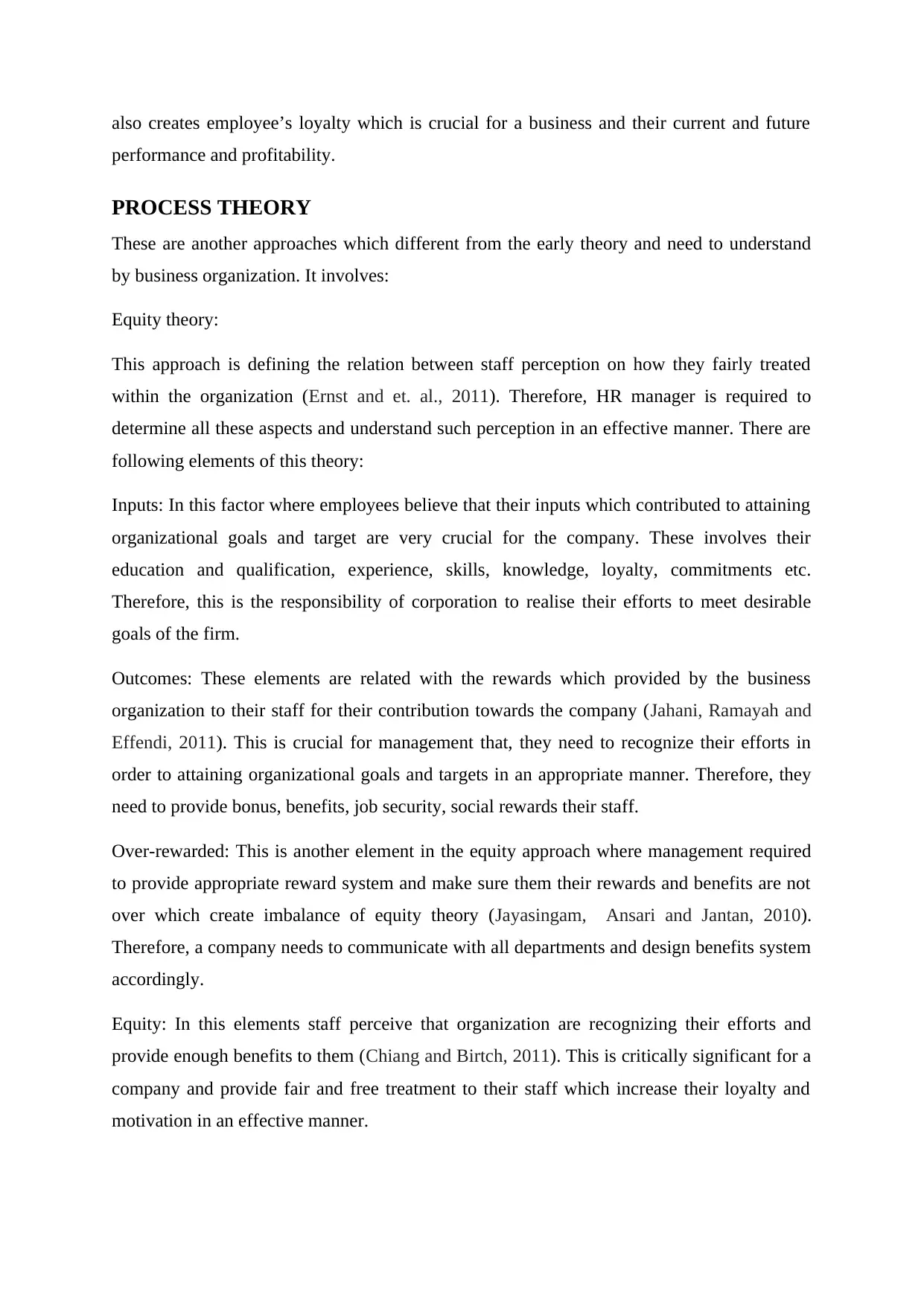
also creates employee’s loyalty which is crucial for a business and their current and future
performance and profitability.
PROCESS THEORY
These are another approaches which different from the early theory and need to understand
by business organization. It involves:
Equity theory:
This approach is defining the relation between staff perception on how they fairly treated
within the organization (Ernst and et. al., 2011). Therefore, HR manager is required to
determine all these aspects and understand such perception in an effective manner. There are
following elements of this theory:
Inputs: In this factor where employees believe that their inputs which contributed to attaining
organizational goals and target are very crucial for the company. These involves their
education and qualification, experience, skills, knowledge, loyalty, commitments etc.
Therefore, this is the responsibility of corporation to realise their efforts to meet desirable
goals of the firm.
Outcomes: These elements are related with the rewards which provided by the business
organization to their staff for their contribution towards the company (Jahani, Ramayah and
Effendi, 2011). This is crucial for management that, they need to recognize their efforts in
order to attaining organizational goals and targets in an appropriate manner. Therefore, they
need to provide bonus, benefits, job security, social rewards their staff.
Over-rewarded: This is another element in the equity approach where management required
to provide appropriate reward system and make sure them their rewards and benefits are not
over which create imbalance of equity theory (Jayasingam, Ansari and Jantan, 2010).
Therefore, a company needs to communicate with all departments and design benefits system
accordingly.
Equity: In this elements staff perceive that organization are recognizing their efforts and
provide enough benefits to them (Chiang and Birtch, 2011). This is critically significant for a
company and provide fair and free treatment to their staff which increase their loyalty and
motivation in an effective manner.
performance and profitability.
PROCESS THEORY
These are another approaches which different from the early theory and need to understand
by business organization. It involves:
Equity theory:
This approach is defining the relation between staff perception on how they fairly treated
within the organization (Ernst and et. al., 2011). Therefore, HR manager is required to
determine all these aspects and understand such perception in an effective manner. There are
following elements of this theory:
Inputs: In this factor where employees believe that their inputs which contributed to attaining
organizational goals and target are very crucial for the company. These involves their
education and qualification, experience, skills, knowledge, loyalty, commitments etc.
Therefore, this is the responsibility of corporation to realise their efforts to meet desirable
goals of the firm.
Outcomes: These elements are related with the rewards which provided by the business
organization to their staff for their contribution towards the company (Jahani, Ramayah and
Effendi, 2011). This is crucial for management that, they need to recognize their efforts in
order to attaining organizational goals and targets in an appropriate manner. Therefore, they
need to provide bonus, benefits, job security, social rewards their staff.
Over-rewarded: This is another element in the equity approach where management required
to provide appropriate reward system and make sure them their rewards and benefits are not
over which create imbalance of equity theory (Jayasingam, Ansari and Jantan, 2010).
Therefore, a company needs to communicate with all departments and design benefits system
accordingly.
Equity: In this elements staff perceive that organization are recognizing their efforts and
provide enough benefits to them (Chiang and Birtch, 2011). This is critically significant for a
company and provide fair and free treatment to their staff which increase their loyalty and
motivation in an effective manner.
Paraphrase This Document
Need a fresh take? Get an instant paraphrase of this document with our AI Paraphraser
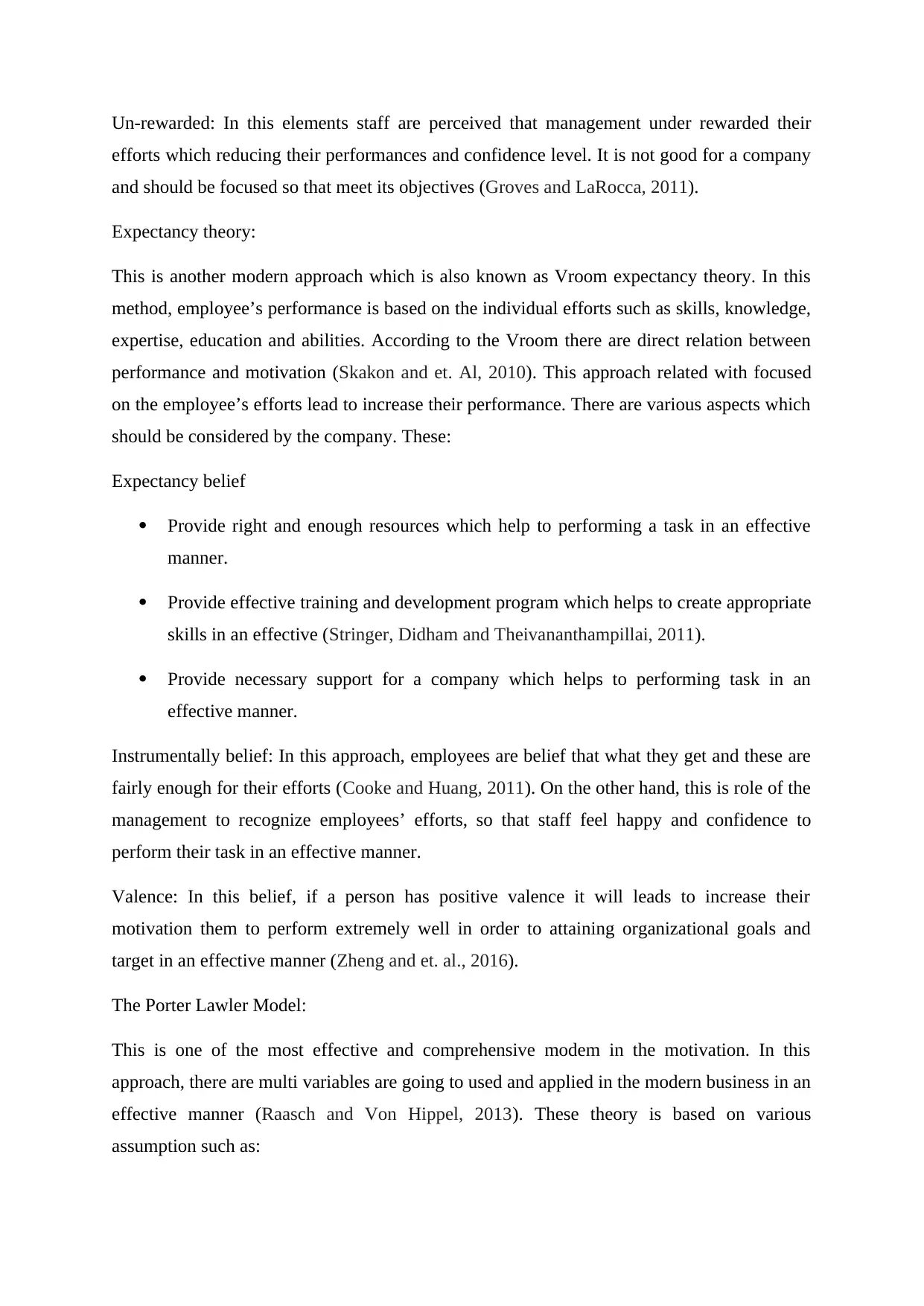
Un-rewarded: In this elements staff are perceived that management under rewarded their
efforts which reducing their performances and confidence level. It is not good for a company
and should be focused so that meet its objectives (Groves and LaRocca, 2011).
Expectancy theory:
This is another modern approach which is also known as Vroom expectancy theory. In this
method, employee’s performance is based on the individual efforts such as skills, knowledge,
expertise, education and abilities. According to the Vroom there are direct relation between
performance and motivation (Skakon and et. Al, 2010). This approach related with focused
on the employee’s efforts lead to increase their performance. There are various aspects which
should be considered by the company. These:
Expectancy belief
Provide right and enough resources which help to performing a task in an effective
manner.
Provide effective training and development program which helps to create appropriate
skills in an effective (Stringer, Didham and Theivananthampillai, 2011).
Provide necessary support for a company which helps to performing task in an
effective manner.
Instrumentally belief: In this approach, employees are belief that what they get and these are
fairly enough for their efforts (Cooke and Huang, 2011). On the other hand, this is role of the
management to recognize employees’ efforts, so that staff feel happy and confidence to
perform their task in an effective manner.
Valence: In this belief, if a person has positive valence it will leads to increase their
motivation them to perform extremely well in order to attaining organizational goals and
target in an effective manner (Zheng and et. al., 2016).
The Porter Lawler Model:
This is one of the most effective and comprehensive modem in the motivation. In this
approach, there are multi variables are going to used and applied in the modern business in an
effective manner (Raasch and Von Hippel, 2013). These theory is based on various
assumption such as:
efforts which reducing their performances and confidence level. It is not good for a company
and should be focused so that meet its objectives (Groves and LaRocca, 2011).
Expectancy theory:
This is another modern approach which is also known as Vroom expectancy theory. In this
method, employee’s performance is based on the individual efforts such as skills, knowledge,
expertise, education and abilities. According to the Vroom there are direct relation between
performance and motivation (Skakon and et. Al, 2010). This approach related with focused
on the employee’s efforts lead to increase their performance. There are various aspects which
should be considered by the company. These:
Expectancy belief
Provide right and enough resources which help to performing a task in an effective
manner.
Provide effective training and development program which helps to create appropriate
skills in an effective (Stringer, Didham and Theivananthampillai, 2011).
Provide necessary support for a company which helps to performing task in an
effective manner.
Instrumentally belief: In this approach, employees are belief that what they get and these are
fairly enough for their efforts (Cooke and Huang, 2011). On the other hand, this is role of the
management to recognize employees’ efforts, so that staff feel happy and confidence to
perform their task in an effective manner.
Valence: In this belief, if a person has positive valence it will leads to increase their
motivation them to perform extremely well in order to attaining organizational goals and
target in an effective manner (Zheng and et. al., 2016).
The Porter Lawler Model:
This is one of the most effective and comprehensive modem in the motivation. In this
approach, there are multi variables are going to used and applied in the modern business in an
effective manner (Raasch and Von Hippel, 2013). These theory is based on various
assumption such as:
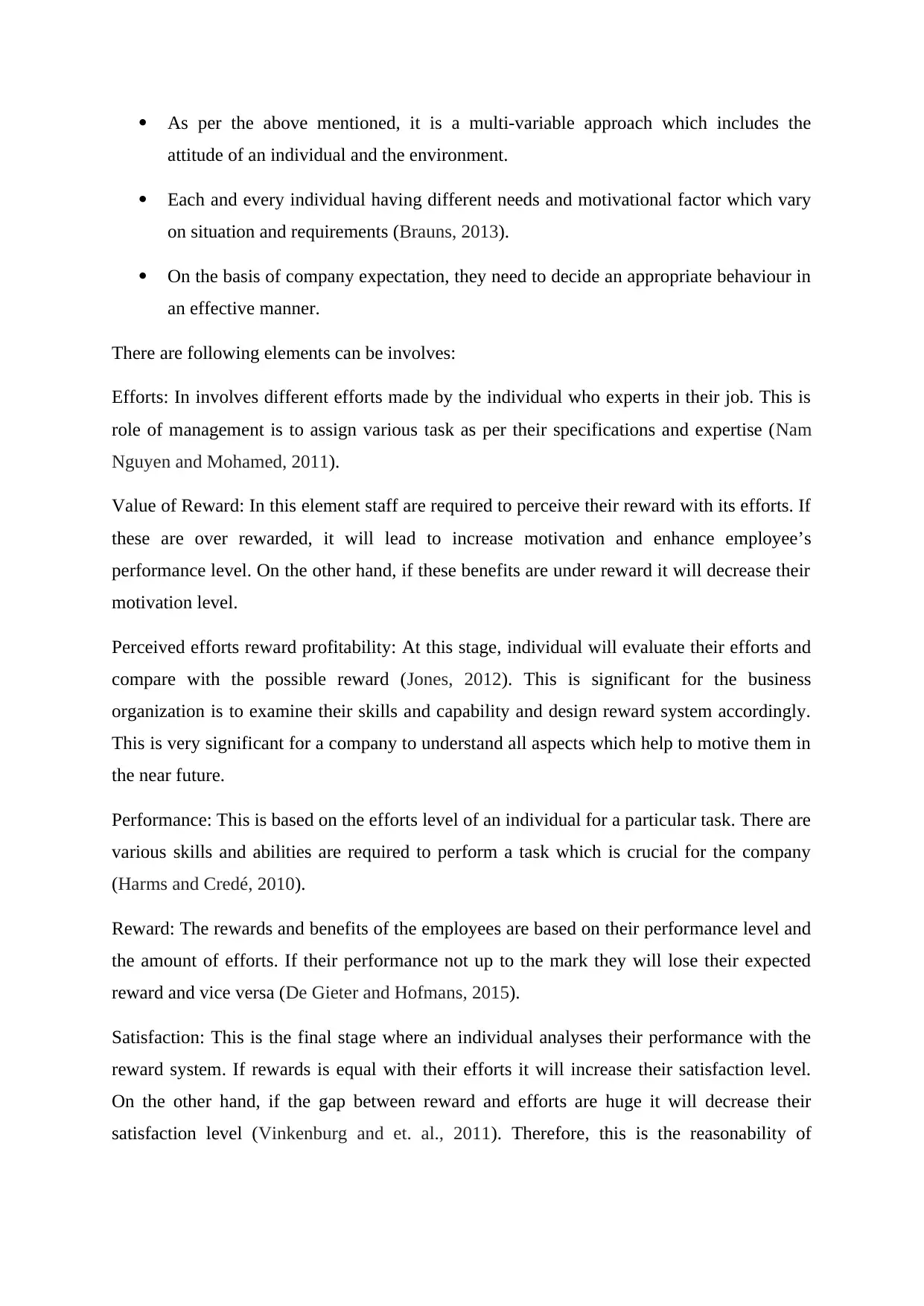
As per the above mentioned, it is a multi-variable approach which includes the
attitude of an individual and the environment.
Each and every individual having different needs and motivational factor which vary
on situation and requirements (Brauns, 2013).
On the basis of company expectation, they need to decide an appropriate behaviour in
an effective manner.
There are following elements can be involves:
Efforts: In involves different efforts made by the individual who experts in their job. This is
role of management is to assign various task as per their specifications and expertise (Nam
Nguyen and Mohamed, 2011).
Value of Reward: In this element staff are required to perceive their reward with its efforts. If
these are over rewarded, it will lead to increase motivation and enhance employee’s
performance level. On the other hand, if these benefits are under reward it will decrease their
motivation level.
Perceived efforts reward profitability: At this stage, individual will evaluate their efforts and
compare with the possible reward (Jones, 2012). This is significant for the business
organization is to examine their skills and capability and design reward system accordingly.
This is very significant for a company to understand all aspects which help to motive them in
the near future.
Performance: This is based on the efforts level of an individual for a particular task. There are
various skills and abilities are required to perform a task which is crucial for the company
(Harms and Credé, 2010).
Reward: The rewards and benefits of the employees are based on their performance level and
the amount of efforts. If their performance not up to the mark they will lose their expected
reward and vice versa (De Gieter and Hofmans, 2015).
Satisfaction: This is the final stage where an individual analyses their performance with the
reward system. If rewards is equal with their efforts it will increase their satisfaction level.
On the other hand, if the gap between reward and efforts are huge it will decrease their
satisfaction level (Vinkenburg and et. al., 2011). Therefore, this is the reasonability of
attitude of an individual and the environment.
Each and every individual having different needs and motivational factor which vary
on situation and requirements (Brauns, 2013).
On the basis of company expectation, they need to decide an appropriate behaviour in
an effective manner.
There are following elements can be involves:
Efforts: In involves different efforts made by the individual who experts in their job. This is
role of management is to assign various task as per their specifications and expertise (Nam
Nguyen and Mohamed, 2011).
Value of Reward: In this element staff are required to perceive their reward with its efforts. If
these are over rewarded, it will lead to increase motivation and enhance employee’s
performance level. On the other hand, if these benefits are under reward it will decrease their
motivation level.
Perceived efforts reward profitability: At this stage, individual will evaluate their efforts and
compare with the possible reward (Jones, 2012). This is significant for the business
organization is to examine their skills and capability and design reward system accordingly.
This is very significant for a company to understand all aspects which help to motive them in
the near future.
Performance: This is based on the efforts level of an individual for a particular task. There are
various skills and abilities are required to perform a task which is crucial for the company
(Harms and Credé, 2010).
Reward: The rewards and benefits of the employees are based on their performance level and
the amount of efforts. If their performance not up to the mark they will lose their expected
reward and vice versa (De Gieter and Hofmans, 2015).
Satisfaction: This is the final stage where an individual analyses their performance with the
reward system. If rewards is equal with their efforts it will increase their satisfaction level.
On the other hand, if the gap between reward and efforts are huge it will decrease their
satisfaction level (Vinkenburg and et. al., 2011). Therefore, this is the reasonability of
⊘ This is a preview!⊘
Do you want full access?
Subscribe today to unlock all pages.

Trusted by 1+ million students worldwide
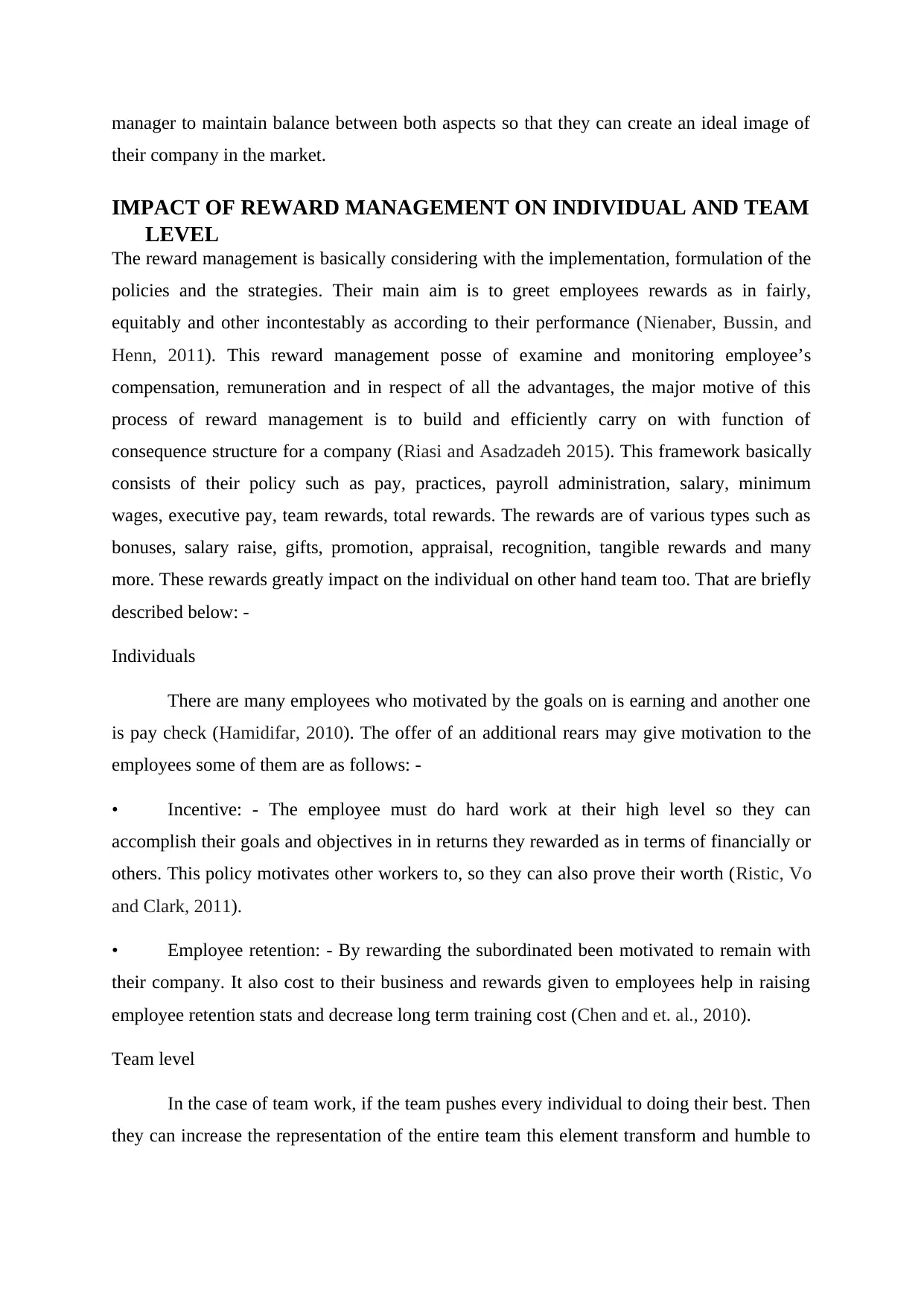
manager to maintain balance between both aspects so that they can create an ideal image of
their company in the market.
IMPACT OF REWARD MANAGEMENT ON INDIVIDUAL AND TEAM
LEVEL
The reward management is basically considering with the implementation, formulation of the
policies and the strategies. Their main aim is to greet employees rewards as in fairly,
equitably and other incontestably as according to their performance (Nienaber, Bussin, and
Henn, 2011). This reward management posse of examine and monitoring employee’s
compensation, remuneration and in respect of all the advantages, the major motive of this
process of reward management is to build and efficiently carry on with function of
consequence structure for a company (Riasi and Asadzadeh 2015). This framework basically
consists of their policy such as pay, practices, payroll administration, salary, minimum
wages, executive pay, team rewards, total rewards. The rewards are of various types such as
bonuses, salary raise, gifts, promotion, appraisal, recognition, tangible rewards and many
more. These rewards greatly impact on the individual on other hand team too. That are briefly
described below: -
Individuals
There are many employees who motivated by the goals on is earning and another one
is pay check (Hamidifar, 2010). The offer of an additional rears may give motivation to the
employees some of them are as follows: -
• Incentive: - The employee must do hard work at their high level so they can
accomplish their goals and objectives in in returns they rewarded as in terms of financially or
others. This policy motivates other workers to, so they can also prove their worth (Ristic, Vo
and Clark, 2011).
• Employee retention: - By rewarding the subordinated been motivated to remain with
their company. It also cost to their business and rewards given to employees help in raising
employee retention stats and decrease long term training cost (Chen and et. al., 2010).
Team level
In the case of team work, if the team pushes every individual to doing their best. Then
they can increase the representation of the entire team this element transform and humble to
their company in the market.
IMPACT OF REWARD MANAGEMENT ON INDIVIDUAL AND TEAM
LEVEL
The reward management is basically considering with the implementation, formulation of the
policies and the strategies. Their main aim is to greet employees rewards as in fairly,
equitably and other incontestably as according to their performance (Nienaber, Bussin, and
Henn, 2011). This reward management posse of examine and monitoring employee’s
compensation, remuneration and in respect of all the advantages, the major motive of this
process of reward management is to build and efficiently carry on with function of
consequence structure for a company (Riasi and Asadzadeh 2015). This framework basically
consists of their policy such as pay, practices, payroll administration, salary, minimum
wages, executive pay, team rewards, total rewards. The rewards are of various types such as
bonuses, salary raise, gifts, promotion, appraisal, recognition, tangible rewards and many
more. These rewards greatly impact on the individual on other hand team too. That are briefly
described below: -
Individuals
There are many employees who motivated by the goals on is earning and another one
is pay check (Hamidifar, 2010). The offer of an additional rears may give motivation to the
employees some of them are as follows: -
• Incentive: - The employee must do hard work at their high level so they can
accomplish their goals and objectives in in returns they rewarded as in terms of financially or
others. This policy motivates other workers to, so they can also prove their worth (Ristic, Vo
and Clark, 2011).
• Employee retention: - By rewarding the subordinated been motivated to remain with
their company. It also cost to their business and rewards given to employees help in raising
employee retention stats and decrease long term training cost (Chen and et. al., 2010).
Team level
In the case of team work, if the team pushes every individual to doing their best. Then
they can increase the representation of the entire team this element transform and humble to
Paraphrase This Document
Need a fresh take? Get an instant paraphrase of this document with our AI Paraphraser
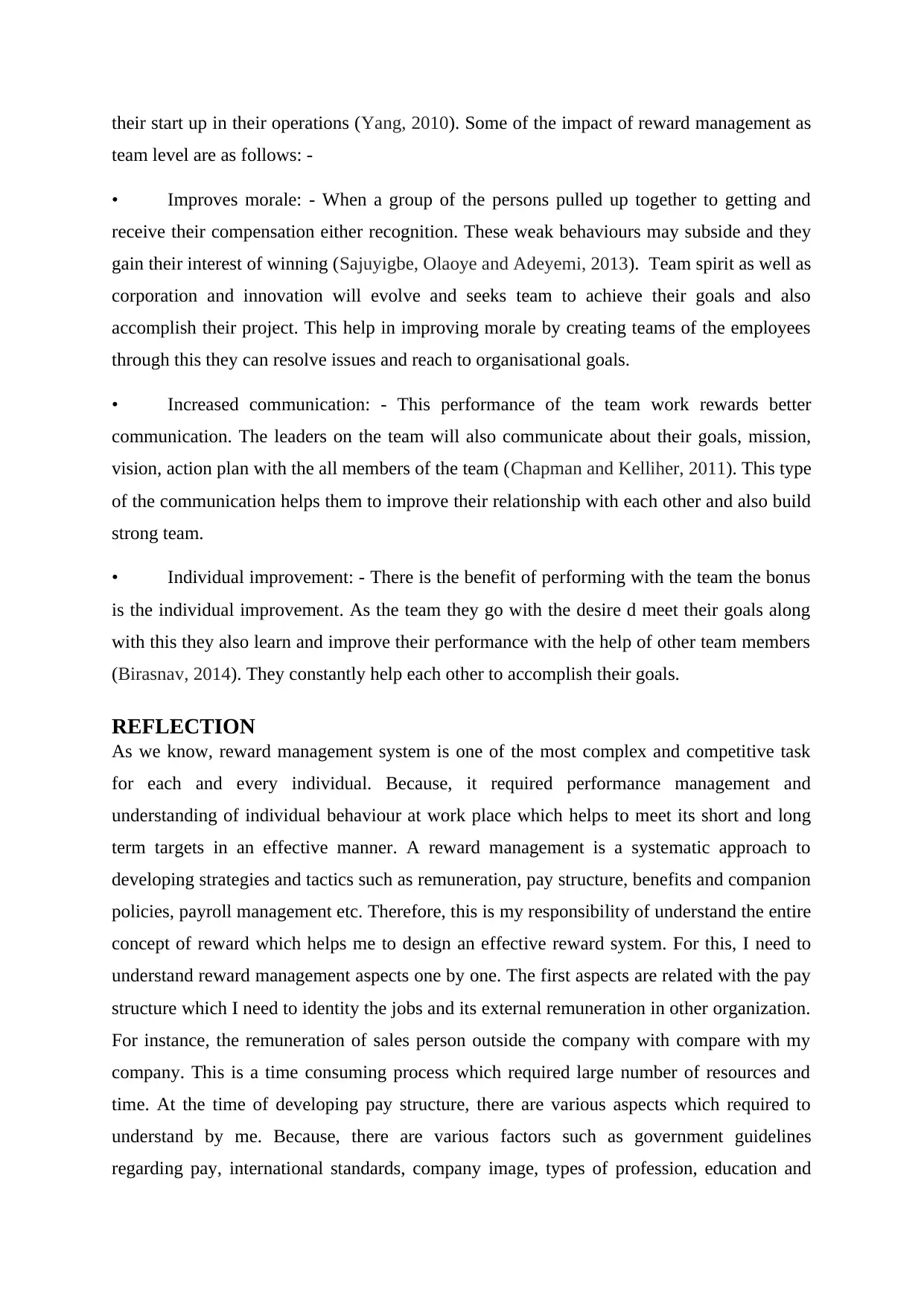
their start up in their operations (Yang, 2010). Some of the impact of reward management as
team level are as follows: -
• Improves morale: - When a group of the persons pulled up together to getting and
receive their compensation either recognition. These weak behaviours may subside and they
gain their interest of winning (Sajuyigbe, Olaoye and Adeyemi, 2013). Team spirit as well as
corporation and innovation will evolve and seeks team to achieve their goals and also
accomplish their project. This help in improving morale by creating teams of the employees
through this they can resolve issues and reach to organisational goals.
• Increased communication: - This performance of the team work rewards better
communication. The leaders on the team will also communicate about their goals, mission,
vision, action plan with the all members of the team (Chapman and Kelliher, 2011). This type
of the communication helps them to improve their relationship with each other and also build
strong team.
• Individual improvement: - There is the benefit of performing with the team the bonus
is the individual improvement. As the team they go with the desire d meet their goals along
with this they also learn and improve their performance with the help of other team members
(Birasnav, 2014). They constantly help each other to accomplish their goals.
REFLECTION
As we know, reward management system is one of the most complex and competitive task
for each and every individual. Because, it required performance management and
understanding of individual behaviour at work place which helps to meet its short and long
term targets in an effective manner. A reward management is a systematic approach to
developing strategies and tactics such as remuneration, pay structure, benefits and companion
policies, payroll management etc. Therefore, this is my responsibility of understand the entire
concept of reward which helps me to design an effective reward system. For this, I need to
understand reward management aspects one by one. The first aspects are related with the pay
structure which I need to identity the jobs and its external remuneration in other organization.
For instance, the remuneration of sales person outside the company with compare with my
company. This is a time consuming process which required large number of resources and
time. At the time of developing pay structure, there are various aspects which required to
understand by me. Because, there are various factors such as government guidelines
regarding pay, international standards, company image, types of profession, education and
team level are as follows: -
• Improves morale: - When a group of the persons pulled up together to getting and
receive their compensation either recognition. These weak behaviours may subside and they
gain their interest of winning (Sajuyigbe, Olaoye and Adeyemi, 2013). Team spirit as well as
corporation and innovation will evolve and seeks team to achieve their goals and also
accomplish their project. This help in improving morale by creating teams of the employees
through this they can resolve issues and reach to organisational goals.
• Increased communication: - This performance of the team work rewards better
communication. The leaders on the team will also communicate about their goals, mission,
vision, action plan with the all members of the team (Chapman and Kelliher, 2011). This type
of the communication helps them to improve their relationship with each other and also build
strong team.
• Individual improvement: - There is the benefit of performing with the team the bonus
is the individual improvement. As the team they go with the desire d meet their goals along
with this they also learn and improve their performance with the help of other team members
(Birasnav, 2014). They constantly help each other to accomplish their goals.
REFLECTION
As we know, reward management system is one of the most complex and competitive task
for each and every individual. Because, it required performance management and
understanding of individual behaviour at work place which helps to meet its short and long
term targets in an effective manner. A reward management is a systematic approach to
developing strategies and tactics such as remuneration, pay structure, benefits and companion
policies, payroll management etc. Therefore, this is my responsibility of understand the entire
concept of reward which helps me to design an effective reward system. For this, I need to
understand reward management aspects one by one. The first aspects are related with the pay
structure which I need to identity the jobs and its external remuneration in other organization.
For instance, the remuneration of sales person outside the company with compare with my
company. This is a time consuming process which required large number of resources and
time. At the time of developing pay structure, there are various aspects which required to
understand by me. Because, there are various factors such as government guidelines
regarding pay, international standards, company image, types of profession, education and
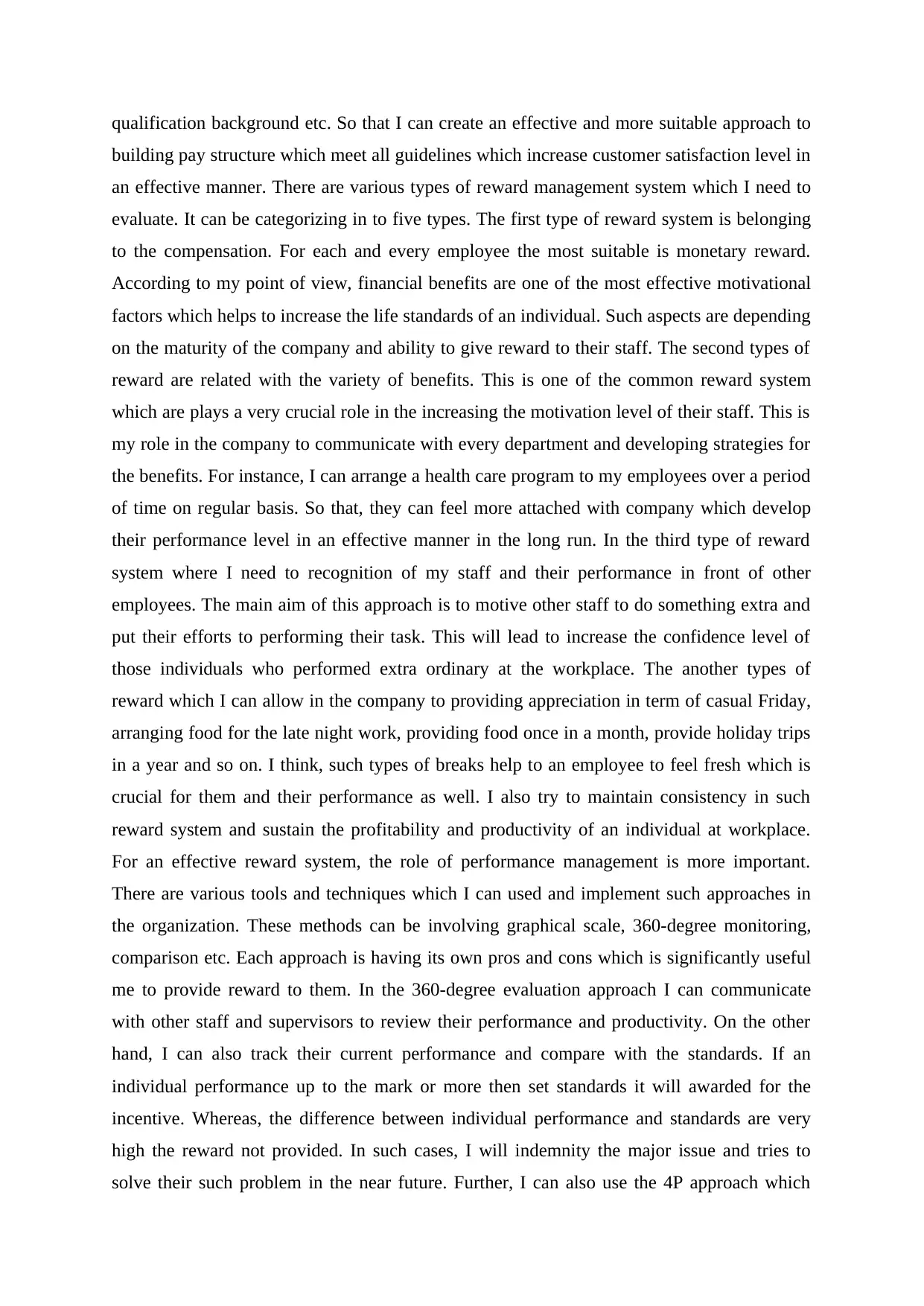
qualification background etc. So that I can create an effective and more suitable approach to
building pay structure which meet all guidelines which increase customer satisfaction level in
an effective manner. There are various types of reward management system which I need to
evaluate. It can be categorizing in to five types. The first type of reward system is belonging
to the compensation. For each and every employee the most suitable is monetary reward.
According to my point of view, financial benefits are one of the most effective motivational
factors which helps to increase the life standards of an individual. Such aspects are depending
on the maturity of the company and ability to give reward to their staff. The second types of
reward are related with the variety of benefits. This is one of the common reward system
which are plays a very crucial role in the increasing the motivation level of their staff. This is
my role in the company to communicate with every department and developing strategies for
the benefits. For instance, I can arrange a health care program to my employees over a period
of time on regular basis. So that, they can feel more attached with company which develop
their performance level in an effective manner in the long run. In the third type of reward
system where I need to recognition of my staff and their performance in front of other
employees. The main aim of this approach is to motive other staff to do something extra and
put their efforts to performing their task. This will lead to increase the confidence level of
those individuals who performed extra ordinary at the workplace. The another types of
reward which I can allow in the company to providing appreciation in term of casual Friday,
arranging food for the late night work, providing food once in a month, provide holiday trips
in a year and so on. I think, such types of breaks help to an employee to feel fresh which is
crucial for them and their performance as well. I also try to maintain consistency in such
reward system and sustain the profitability and productivity of an individual at workplace.
For an effective reward system, the role of performance management is more important.
There are various tools and techniques which I can used and implement such approaches in
the organization. These methods can be involving graphical scale, 360-degree monitoring,
comparison etc. Each approach is having its own pros and cons which is significantly useful
me to provide reward to them. In the 360-degree evaluation approach I can communicate
with other staff and supervisors to review their performance and productivity. On the other
hand, I can also track their current performance and compare with the standards. If an
individual performance up to the mark or more then set standards it will awarded for the
incentive. Whereas, the difference between individual performance and standards are very
high the reward not provided. In such cases, I will indemnity the major issue and tries to
solve their such problem in the near future. Further, I can also use the 4P approach which
building pay structure which meet all guidelines which increase customer satisfaction level in
an effective manner. There are various types of reward management system which I need to
evaluate. It can be categorizing in to five types. The first type of reward system is belonging
to the compensation. For each and every employee the most suitable is monetary reward.
According to my point of view, financial benefits are one of the most effective motivational
factors which helps to increase the life standards of an individual. Such aspects are depending
on the maturity of the company and ability to give reward to their staff. The second types of
reward are related with the variety of benefits. This is one of the common reward system
which are plays a very crucial role in the increasing the motivation level of their staff. This is
my role in the company to communicate with every department and developing strategies for
the benefits. For instance, I can arrange a health care program to my employees over a period
of time on regular basis. So that, they can feel more attached with company which develop
their performance level in an effective manner in the long run. In the third type of reward
system where I need to recognition of my staff and their performance in front of other
employees. The main aim of this approach is to motive other staff to do something extra and
put their efforts to performing their task. This will lead to increase the confidence level of
those individuals who performed extra ordinary at the workplace. The another types of
reward which I can allow in the company to providing appreciation in term of casual Friday,
arranging food for the late night work, providing food once in a month, provide holiday trips
in a year and so on. I think, such types of breaks help to an employee to feel fresh which is
crucial for them and their performance as well. I also try to maintain consistency in such
reward system and sustain the profitability and productivity of an individual at workplace.
For an effective reward system, the role of performance management is more important.
There are various tools and techniques which I can used and implement such approaches in
the organization. These methods can be involving graphical scale, 360-degree monitoring,
comparison etc. Each approach is having its own pros and cons which is significantly useful
me to provide reward to them. In the 360-degree evaluation approach I can communicate
with other staff and supervisors to review their performance and productivity. On the other
hand, I can also track their current performance and compare with the standards. If an
individual performance up to the mark or more then set standards it will awarded for the
incentive. Whereas, the difference between individual performance and standards are very
high the reward not provided. In such cases, I will indemnity the major issue and tries to
solve their such problem in the near future. Further, I can also use the 4P approach which
⊘ This is a preview!⊘
Do you want full access?
Subscribe today to unlock all pages.

Trusted by 1+ million students worldwide
1 out of 17
Related Documents
Your All-in-One AI-Powered Toolkit for Academic Success.
+13062052269
info@desklib.com
Available 24*7 on WhatsApp / Email
![[object Object]](/_next/static/media/star-bottom.7253800d.svg)
Unlock your academic potential
Copyright © 2020–2025 A2Z Services. All Rights Reserved. Developed and managed by ZUCOL.





